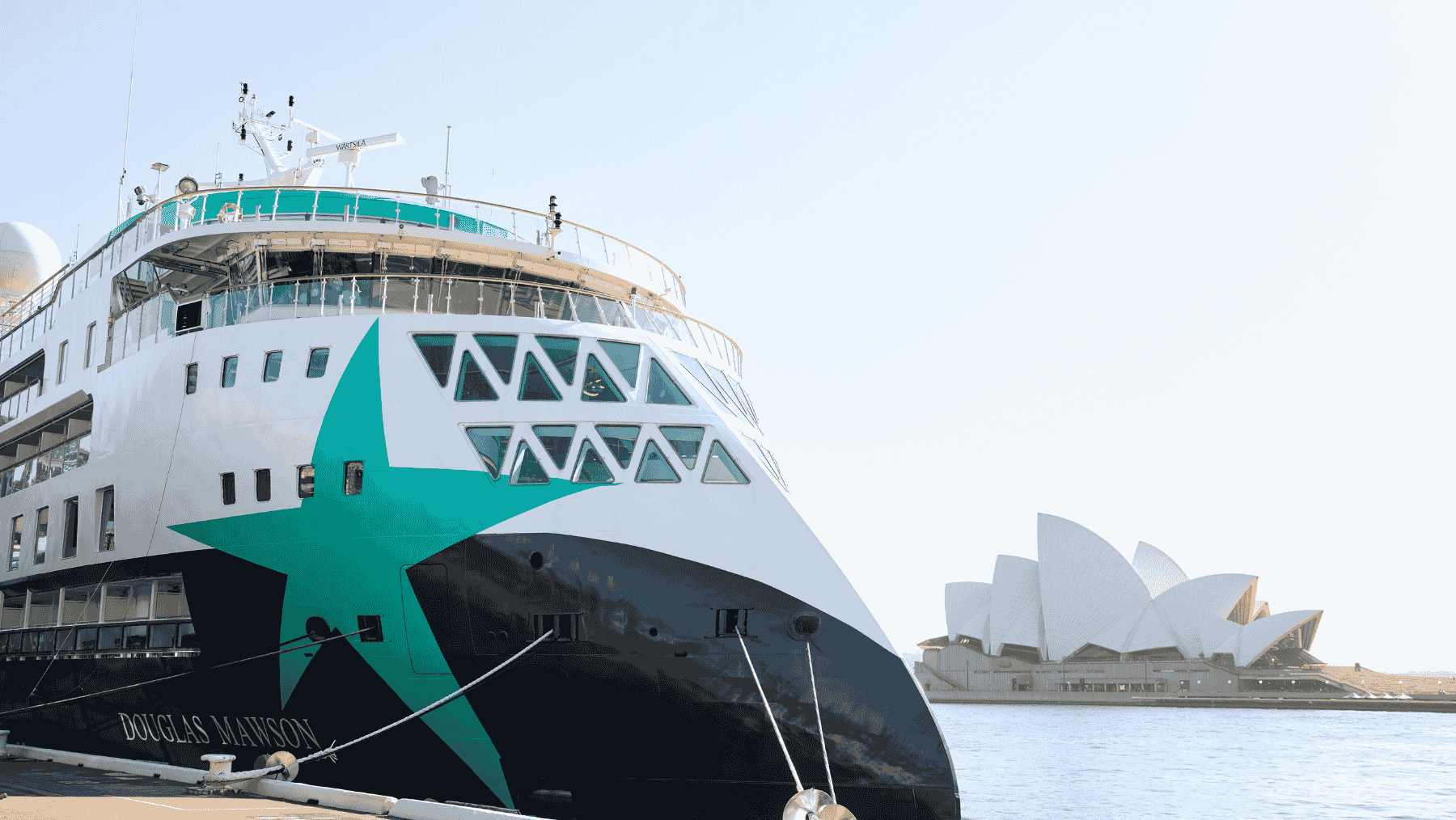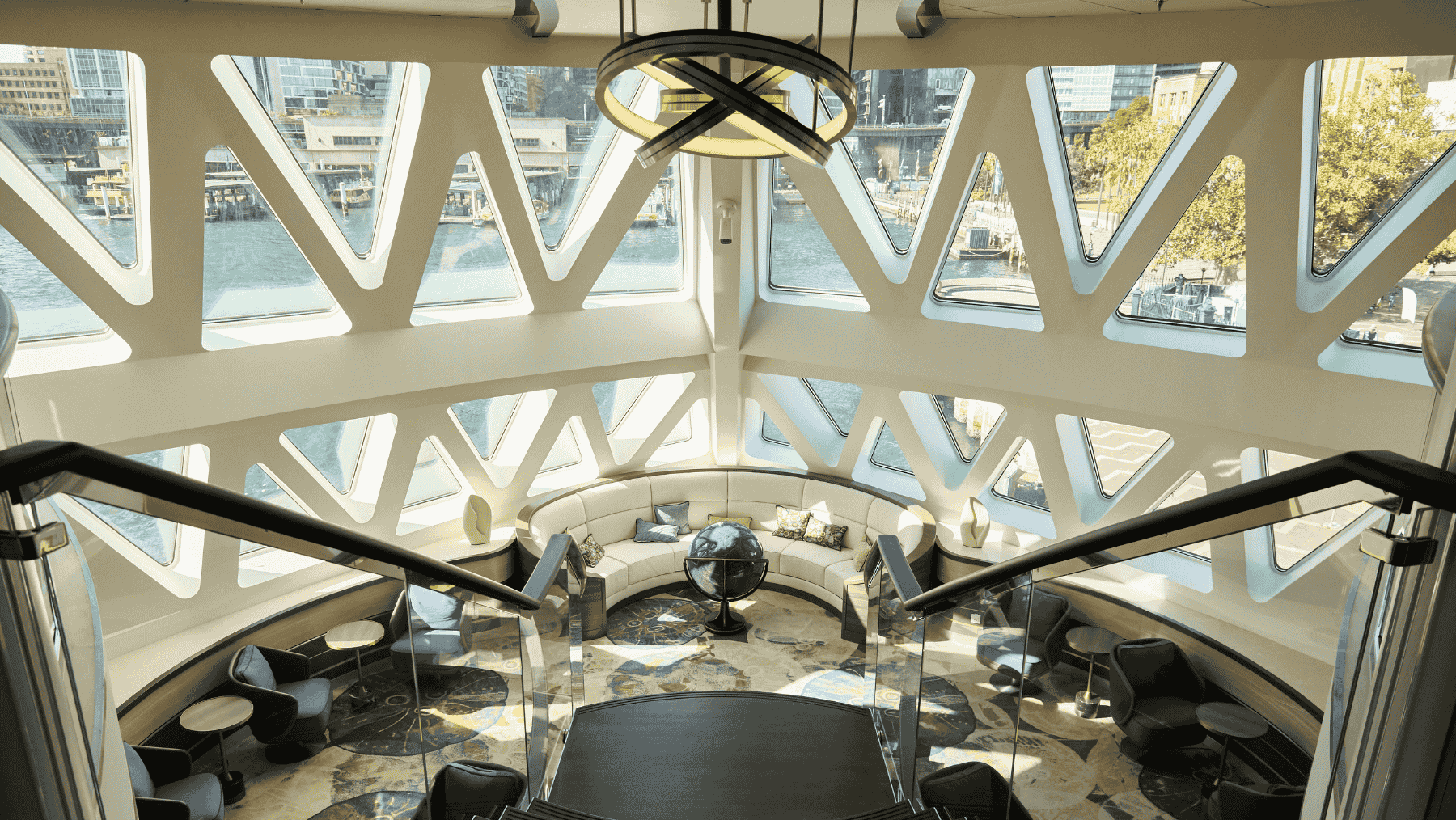- Publisher Peter Lynch reports from the Douglas Mawson, Aurora Expeditions newest ship.
- The vessel is a ground-breaking addition to the Aurora fleet, taking the line created three decades ago to a new level.
- Here’s our guide to what’s on board.
Aurora Expeditions made maritime history on Sydney Harbour as it unveiled its newest ship, the Douglas Mawson, in a ceremony as unconventional and proudly Australian as the company behind it.
For the first time, a cruise ship was christened not with champagne, but with ice.
Emma McEwin, great-granddaughter of Aussie Antarctic explorer Sir Douglas Mawson, stepped forward carrying a block of ice. With one decisive strike, she shattered it across the ship’s distinctive X-BOW, sending fragments skimming down the hull.
“Replacing champagne with ice was a deliberate and powerful choice — it reflects who we are.”
— Greg Mortimer, Founder, Aurora Expeditions
“To christen this remarkable ship in my great-grandfather’s name is an immense honour,” McEwin said. “The Douglas Mawson carries forward his legacy of courage, science and wonder.”
Read more on the ship’s arrival in Sydney at Cruise Passenger.

Honouring Mawson’s legacy
Mortimer, the mountaineer who founded Aurora Expeditions 35 years ago, said of the ceremony: “Replacing champagne with ice was a deliberate and powerful choice,.
“It reflects who we are — explorers of the polar regions, advocates for our planet and proud custodians of Australia’s legacy of adventure.”
Sir Douglas Mawson himself would probably have approved. The pioneering geologist and expedition leader reshaped global understanding of Antarctica through the Australasian Antarctic Expedition (1911–1914). His extraordinary solo survival trek — after losing both his companions — remains one of the greatest feats in polar history.
Today, that spirit lives on.
The Little Aussie Battler of expedition
In a global expedition cruising market dominated by larger foreign-owned operators, Aurora Expeditions remains proudly Australian. For 35 years the company has fought and thrived.
With the Douglas Mawson, Aurora proves something important: being small is not necessarily a weakness. Aurora offers Australians a true homegrown choice.
No-one would reveal the investment cost of the new ship, though some reports have put it at around $100 million.
On board the shakedown cruise were recognisable heroes like Dick Smith, the adventure pioneer, and there is no doubt Aurora has some local investors.
This new ship is Aurora’s declaration that there is still power and appeal in authenticity, science, curiosity and genuine exploration. And she is riding a tide of interest from a new generation of cruisers who want to see the world in a new way.
A refined new era of exploration
As I settle into Cabin 611 on this first shakedown voyage, the ship still carries the unmistakable scent of newness. My cabin is well-designed and surprisingly spacious, with:
- ample storage
- a proper desk and chair for writing or research,
- a comfortable bed,
- a surprisingly large balcony perfect for whale watching, seabird spotting, or simply soaking up the Southern Ocean air.
I loved the fact that the shower head has a temperature gauge and a timer.
The television system offers documentaries, bridge feeds, maps and full access to the lecture program. But it’s outside the cabin where the ship truly shines.

The Library: A masterpiece of X-BOW design
The standout space — and perhaps the most inspiring room at sea — is the ship’s two-storey forward library, perched directly above the innovative X-BOW.
Sunlit, quiet, beautifully furnished and lined with books on geology, polar history, ornithology and oceanography, it could be the intellectual heart of the vessel.
It could well be the most beautiful library ever to sail under an Australian flag. It is a place where travellers don’t just read about the world — they watch it.
Built for science and adventure
The Douglas Mawson is Aurora’s most capable and technologically advanced ship to date. Here’s why:
- Ulstein X-BOW – for reduced pitching and smoother, more efficient voyages
- Fuel-efficient diesel-electric propulsion
- Waste-heat recovery to lower emissions
- Dynamic positioning to protect fragile seabeds
- Ice-strengthened hull for polar conditions
It has a fully equipped Citizen Science Centre, a large team of geologists, ornithologists, marine biologists and historians, 15 Zodiacs, kayaks, diving and snorkelling programs. There are wide exterior decks for wilkdlife viewing and a large lecture theatre.
To travel aboard Aurora’s Douglas Mawson is to travel with purpose. Guests are typically knowledge seekers — inquisitive, engaged and eager to participate in the ship’s scientific programs.
During the opening briefing in the lounge, our expedition leader captured the ethos perfectly:
“We are a temporary community experiencing a wild environment together.”
A journey steeped in history
Following its christening, Douglas Mawson set a course for Hobart, where it will begin its 10-night inaugural circumnavigation of Tasmania led by environmental scientist and adventurer Tim Jarvis AM.
Jarvis is uniquely qualified for this honour: he famously re-enacted Mawson’s survival journey and Shackleton’s open-boat voyage.
From Tasmania, the ship will push on to Antarctica, South Georgia and the Sub-Antarctic Islands
Why the Douglas Mawson matters
For Australians wanting authenticity, education, and a real connection to the environment, the Douglas Mawson is a landmark achievement. It honours our past, represents our present, and charts a future where Australian exploration remains at the forefront of global expedition travel.
Douglas Mawson: Fact file
Operator: Aurora Expeditions (Australian-owned)
Launched: 2025
Class: Polar Class 6 expedition vessel
Passenger capacity: 154 (130 in polar regions)
Crew: 80 including expedition/science team
Hull: Ulstein X-BOW wave-piercing design
Propulsion: Diesel-electric + waste-heat recovery
Ship Guide: Suites, cabins and onboard Facilities
Cabin and suite categories
According to the official spec sheet from Aurora Expeditions, Douglas Mawson offers its most extensive range of accommodation yet — 10 different types of staterooms and suites, including a selection of single-berth cabins for solo travellers.
Some of the key cabin and suite types include:
- Captain’s Suite — roughly 45.2 m² (≈ 486 ft²), on Deck 4. Includes private ensuite, a separate lounge area, full-size windows + a balcony, desk space, safe, 42″ TV and minibar.
- Junior Suite — around 41.5–41.9 m² (≈ 446–451 ft²), on Deck 7, similarly well-appointed with balcony, ensuite, lounge / desk / wardrobe, TV and minibar.
- Balcony Staterooms (Superior / Category A / Category B) — ranging roughly from 22 to 36 m² depending on sub-category, all with private ensuites and balconies (or at least large windows), with desk/closet space and standard amenities.
- Single-berth / twin / double staterooms — for solo adventurers or pairs, offering a comfortable, private base with en-suite facilities.
Onboard facilities
The ship is well-equipped for both comfort and serious expedition work. Among the features are:
- Revolutionary X-BOW design: The wave-piercing bow design ensures smoother passages, less pitching and better fuel efficiency.
- Heated outdoor swimming pool, two Jacuzzis, pool bar, sauna and gym — perfect for post-expedition relaxation or warming up after a cold polar plunge.=
- Multiple observation lounges & decks, plus indoor spaces with floor-to-ceiling windows for wildlife watching, scenic viewing and socialising.
- Lecture theatre + Citizen Science Centre & lounge — on every expedition, you’ll have access to naturalists, scientists and experts hosting lectures, presentations and interactive citizen-science programs.
- Expedition-ready infrastructure — Zodiac launch points, mudroom for gear and boots, rapid drying facilities, and efficient embarkation platforms to make shore landings quick and safe.
- Dining & social spaces — open-seating restaurants, bars, lounges; communal meals, a pool bar; shared spaces encouraging camaraderie among guests.
See more here: www.aurora-expeditions.com








